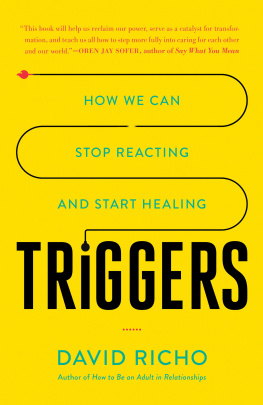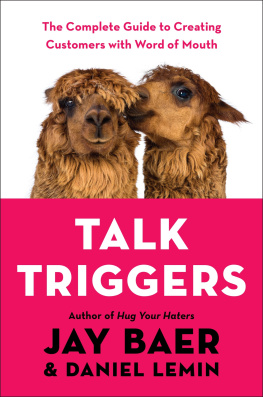Witchcraft, Green Peas, and Sigmund Freud
M ore weight! cried the old man, begging to be crushed more quickly. More weight!
It was the summer of 1692, in Salem village. The old mans ribs snapped one by one, in sickening succession, each audible to the hundreds of townsfolk encircling his execution. But his pleas were answered instead with the same slow addition of stones upon his chest. For two days, six large men lifted stone and rock onto Giles Coreys torso. But Corey refused to confess to any charges, asking only for more weight to speed his death. The sheriff stood over him, impatiently waiting for a confession, using his cane to push the old mans tongue back inside his mouth. At last, Corey was silenced by the final stone dropping upon his breast. His crime? The concept of fascination didnt begin with Giles Coreys execution in Salem village. Throughout cultures, across the continents, since the birth of civilization itself, people have studied the ways in which fascination influences behavior. The word fascination comes from the ancient Latin, fascinare , to bewitch.
All around the world, ancient cultures were fascinated with fascination. The Romans believed it was an evil curse, and for protection worshipped one of the earliest Latin divinities: Fascinus, the god of fascination. In Mesopotamia, Persians believed fascination could cause deadly maladies. In Constantinople, citizens painted passages from the Koran upon their houses to defend their families from the spell of fascinations evil eye. Fortunately, by 280 B.C ., Greeces first pastoral poet, Theocritus, seemed to have found a safeguard: an old womans spit. During the Renaissance, the bookshelves of Europe were filled with weighty tomes on the subject. De Fascino defined fascination as an open covenant with Satanwitchcraft of the eyes, or wordsto so compel men that they are no longer free, nor of sane understanding. A hundred years later, Tractatus de Fascinatione warned against lounging in bed too late in the morning wearing nightcaps (yes, nightcaps), or breaking a religious fast on green peas (yes, green peas).
How to prevent and cure? In many cases, the remedy seems almost worse than the disease: the skin of a hyenas forehead, dust in which a mule had rolled, and a broth stewed from the ashes of a hangmans rope. Not exactly goods you could pick up on an afternoon Costco run. In the absence of hyena forehead skin, it seems one could also lick the skin of a childs forehead.
If all that sounds like quackery, lets consult a doctor with whom you might be more familiar: Sigmund Freud. In 1921, Freud labeled the relationship between a therapist and a patient as fascination, a form of hypnosis. He went on to describe romantic love as a state in which an individual becomes so submissively engrossed in his object of fascination that he becomes hypnotized, losing his critical faculties, in bondage of love. Freud, apparently, wasnt the only one comparing fascination with hypnosis. The 1911 edition of the Encyclopaedia Britannica describes fascination as a hypnotic condition, marked by muscular contraction, but with consciousness and power of remembrance.
Even our modern Websters Dictionary sounds a bit sinister in comparing fascination to witchcraft: bewitching, or enchantingthe exercise of a powerful or irresistible influence on the affections or passions; unseen, inexplicable influence.
Yet as well see, the ability to fascinate isnt witchcraft or hypnotism. And it doesnt come from wearing nightcaps or eating green peas. It is a tool. Rather than something to be feared, it is a discipline to be mastered. Fascination is born of a natural instinct to influence the behavior of others. But the key to mastering fascination is effectively activating the seven triggers:
LUST creates craving for sensory pleasure.
MYSTIQUE lures with unanswered questions.
ALARM threatens with negative consequences.
PRESTIGE earns respect through symbols of achievement.
POWER commands and controls.
VICE tempts with forbidden fruit, causing us to rebel against norms.
TRUST comforts us with certainty and reliability.
Whether you realize it or notwhether you intend to or notyoure already using the seven triggers. The question is, are you using the right triggers, in the right way, to get your desired result? By mastering the triggers, your ideas become more memorable, your conversations more persuasive, and your relationships more lasting.
Across the ages, scholars have described the powers of fascination. Century after century, theyve told us how to recognize when someone is in a state of fascination. Society after society, theyve defined why fascination matters. Theyve described repeatedly, and at length, the ways in which fascination affects decision making. Yet throughout two thousand years of writings, one question remains unanswered. And this is the most important question of all:
How can you become more fascinating?
Lets find out.
What Is Fascination, Exactly?
How I Became Fascinated with Fascination
Growing up in my family, earning attention wasnt a recreational pursuit. It was a matter of survival. Like any youngest child, I had to compete with older siblings for attention. By toddlerhood Id honed numerous strategies, from the strategically executed tantrum to the art of asking, Why? Why? Why?
But then, when I turned seven, I was forced to raise my game. That year, my sister was number one in the world in her swimming event (and went on to win three gold medals in the Olympics), and my brother was accepted into Harvard. The height of my achievement up to that point? Gold stars for finger painting. It was then that I learned my first lesson in fascination: A competitive environment demands a more captivating message. Perhaps it wont come as a surprise that I went into marketing. Now I create messages for companies whose competitive environments demand captivating messages.
In a distracted and overwhelmed world, everythingincluding you, your communication, and your relationshipsfights tooth and nail to get noticed. Without fascination we cant sell products off shelves, persuade shareholders to invest, teach students to read, or convince spouses to vacation in Bora Bora next February. Yet with fascination on your side, not only can you vacation in Bora Bora; you can also unlock your own creative potential.










